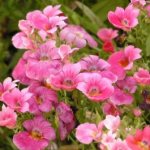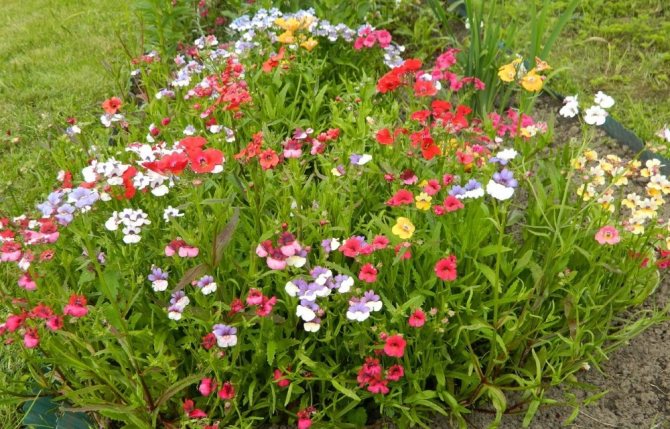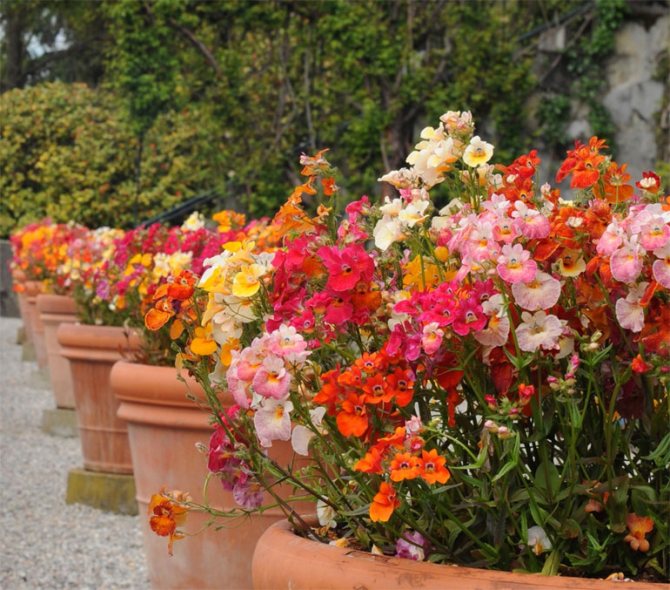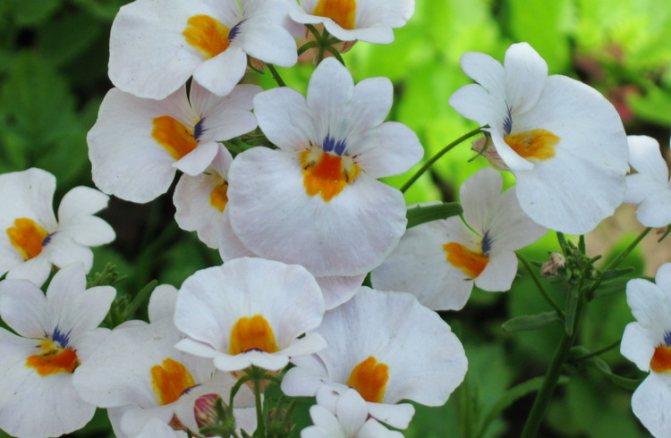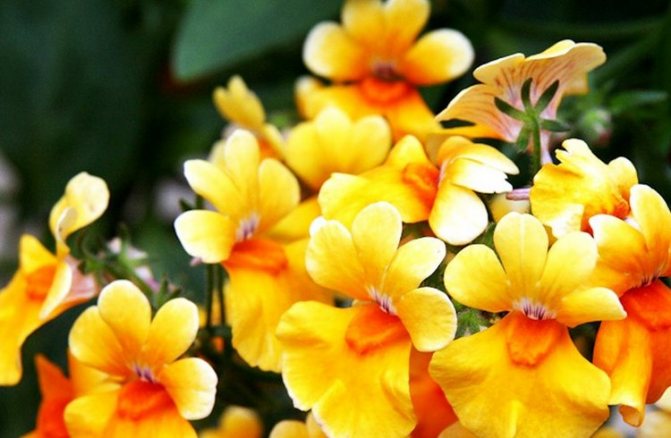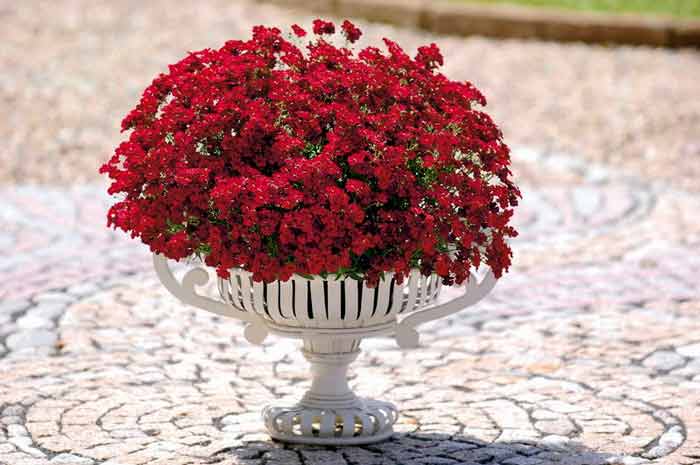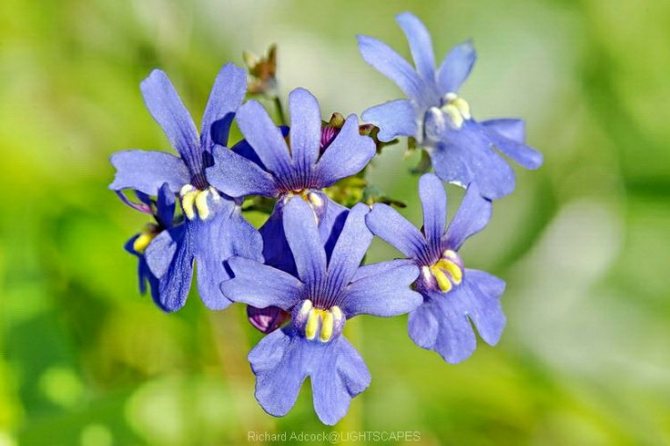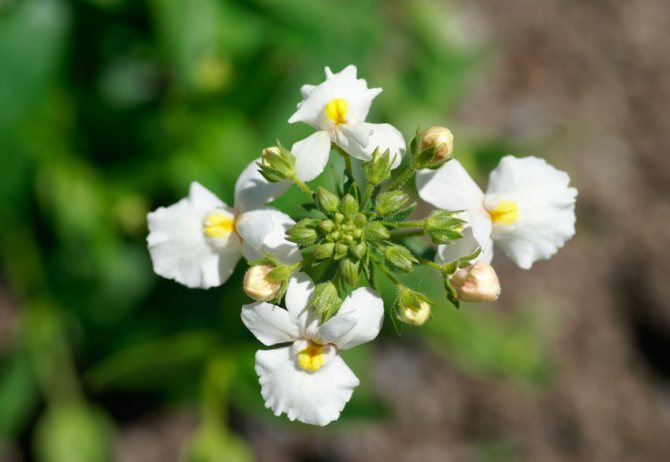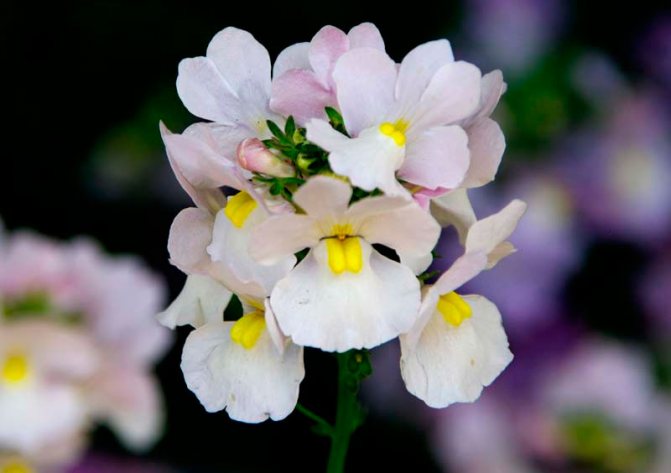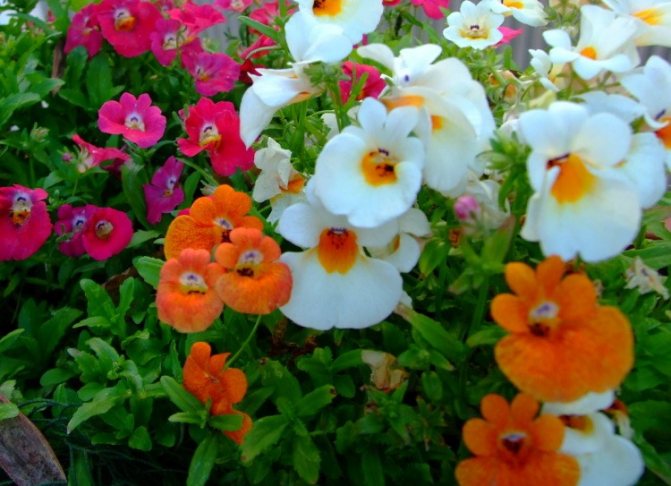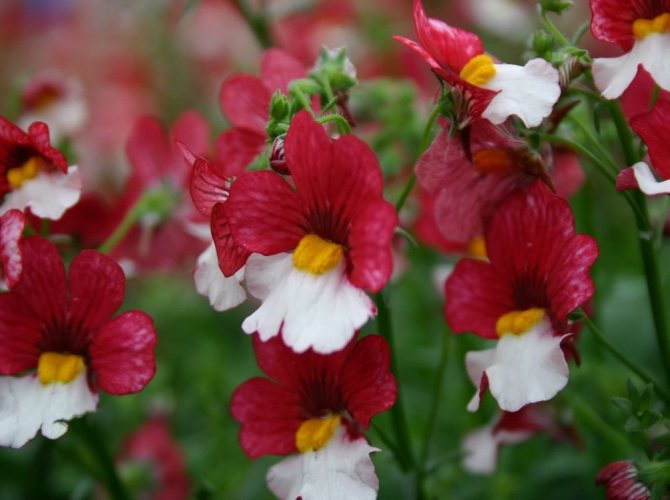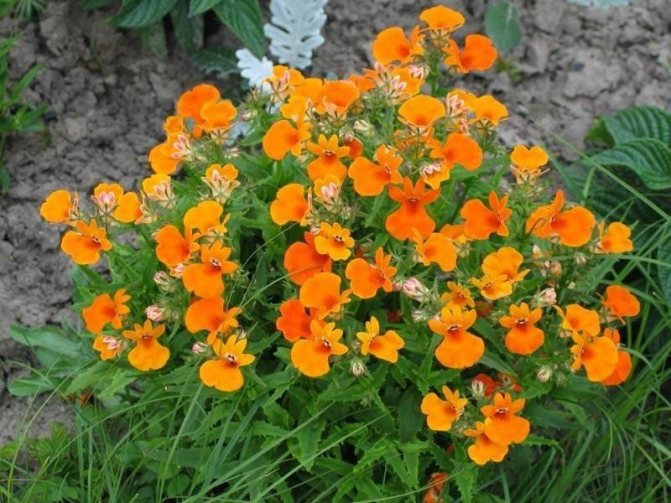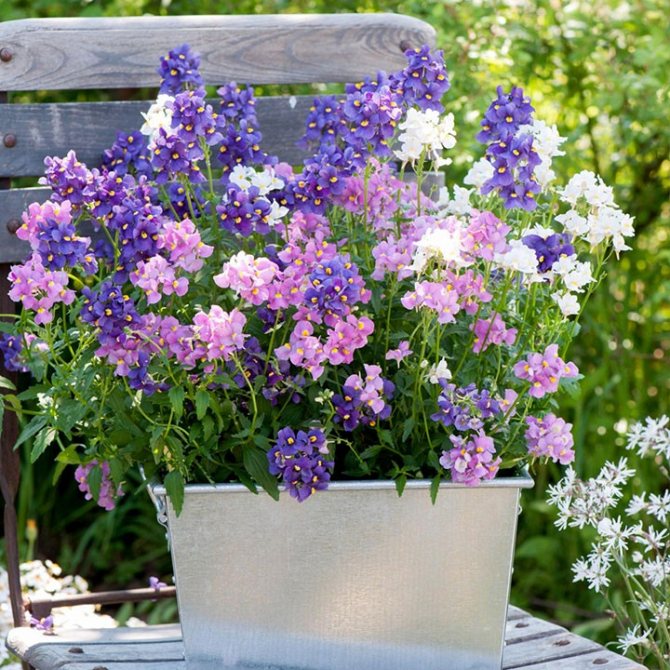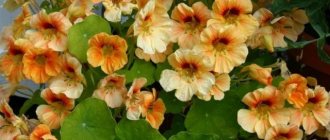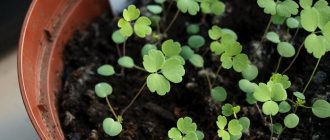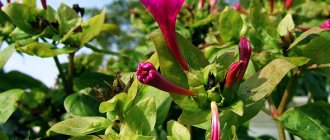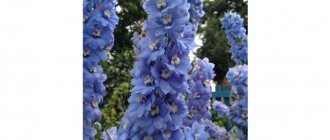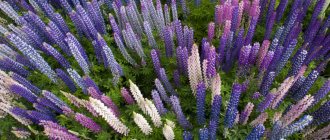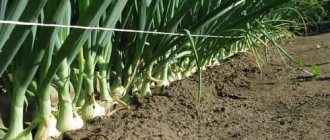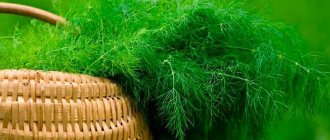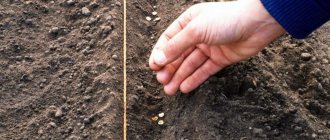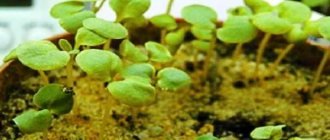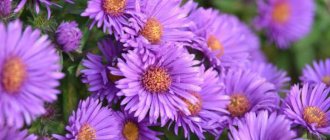The plant is a guest in our area: its homeland is South African lands, so it loves the sun and moisture. Grown in an annual culture and as a perennial.
Anyone who is fond of flower cultivation will not disregard nemesia, which is distinguished by a variety of forms and play of bright shades. Its close relative is snapdragon, which grows everywhere in flower beds and is well known to gardeners. Although it got its name from the formidable Nemesis, the goddess of retribution, the plant does not pose any threat to beauty lovers. On the contrary, it delights with the tenderness of the flowers, their unusual festive cheerful color. But for the holiday to take place, you need to familiarize yourself with the conditions under which nemesia will feel most comfortable.
Description of the plant, species and varieties
The genus Nemesia belongs to the leporidae (Scrophulariaceae) family and includes several dozen species, differentiated into annuals and perennials. Plants vary in size depending on the species and variety.
The following types of nemesia are known:
- Altbitflora (Nemesia albiflora),
- Bearded (N. barbata),
- Grandiflora (grandiflora),
- Two-horned (N. Bicornis),
- Goiter (N. Strumosa),
- Large-fruited (N. Macrocarpa),
- Bushy (N. Fruticans),
- Lilac (N. Lilacina),
- Fine-toothed (N. Denticulata),
- Cirrus (N. Pinnata),
- Multi-colored (N. Versicolor),
- Fleck (N. Fleckii).
In our gardens, the goiter species (Nemesia strumosa) is mainly found. Its greatest value is bell-shaped flowers with a wide upper petal and several smaller petals in the lower lip of the flower. Goiter nemesia is found in one or two colors, white, yellow, orange, pink or red. Blooms from June to September.
You can choose a more sprawling plant (Nemesia fruticans - bushy) or a compact plant with raised stems (a hybrid of the Karoo series). Nemesia fruticans is characterized by a unique asymmetrical structure, its abundantly flowering bushes will be a wonderful decoration for a flower bed or balcony.

The varieties in the Sunsatia series have slightly spreading stems and flowers in fiery white and pink tones. They can be used in standing pots and hanging baskets. Varieties of the Karoo group are more compact, have low shoots and inflorescences, flowering is very abundant, mainly in cold flowers.
The new varieties from the Maritana series boast large, beautiful flowers of various colors. This plant usually grows up to 30-40 cm in height. Maritana Scented Lady is characterized by white and inky flower petals. Their branched, angular stems and small toothed leaves are gathered in loose clusters. The varieties from the Maritana series usually bloom from June to August.
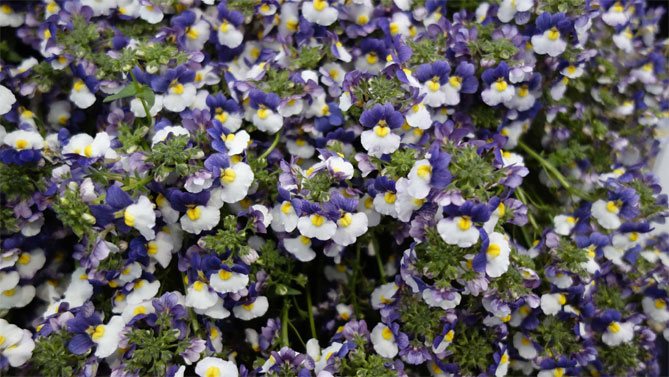

Abundant flowering of nemesia occurs from June to September. Flowers of nemesia, collected in loose inflorescences, have a bell-shaped shape with a characteristic structure - 2 lip-shaped limbs. The upper lip is smaller in size - four-lobed, the lower lip is larger, single or dicotyledonous, sometimes with a spur. The color of the flowers is very varied: white, blue, orange, red, purple, pink, yellow, two-tone and in many shades of the aforementioned colors.
The height of plants, depending on the variety, series reaches 30-40 cm.
On sale most often you can find Goiter nemesia and hybrids, which are presented in numerous, bright versions, grouped into certain series.
Known goiter-like series:
- Nemesia Carnival,
- Triumph.
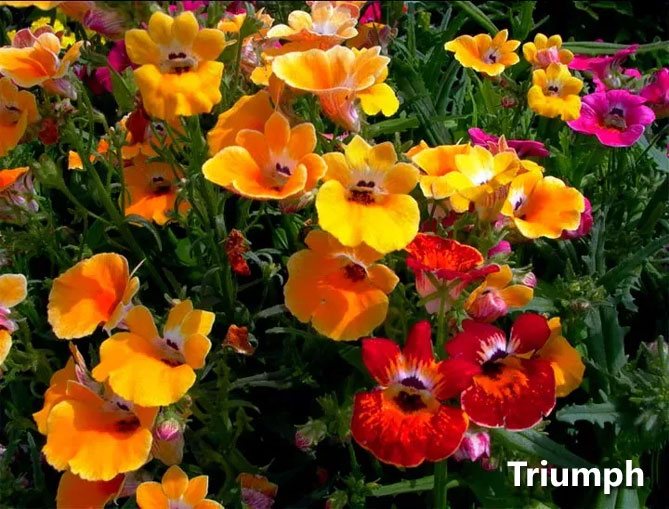

Popular garden hybrids:
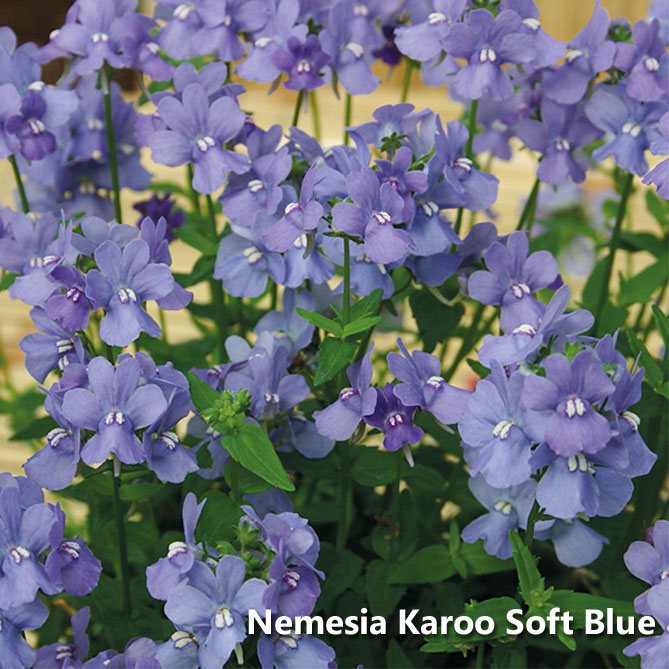

The most beautiful varieties:
- Orange Prince Orange Prince is a variety characterized by orange flowers. Height 15-20 cm.
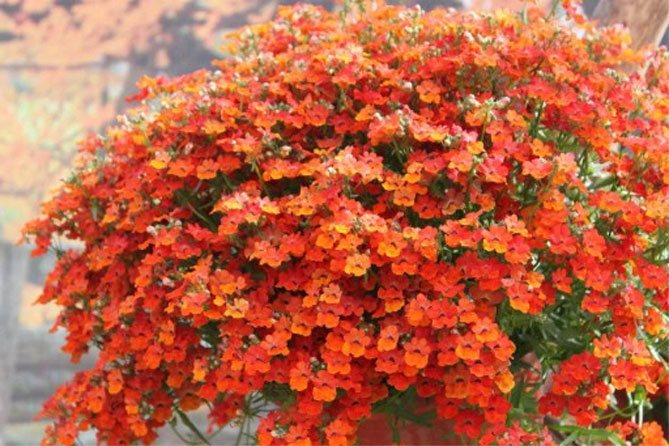

- The Fire King is a cultivar with beautiful, expressive red flowers.
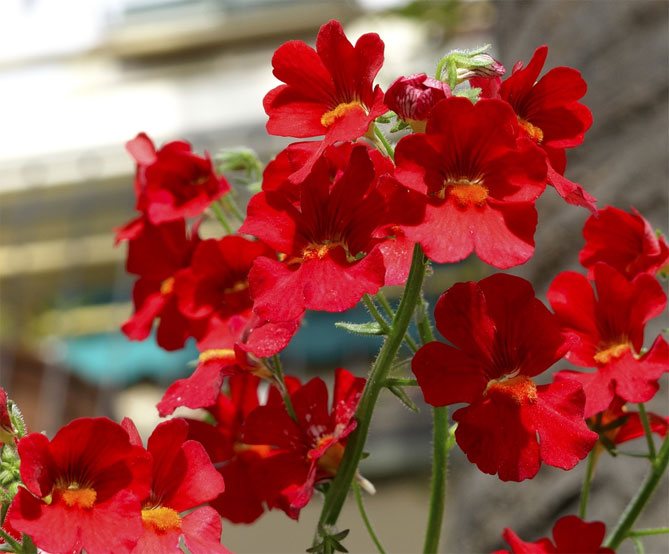

- Blue Gem Blue Gem is a very interesting variety that charms with blue flowers.
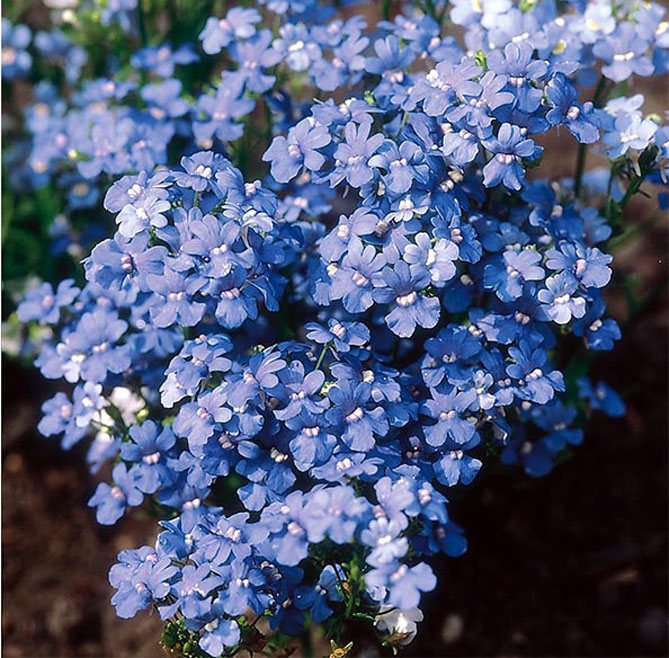

- Sunsatia Lemon are yellow flowers.
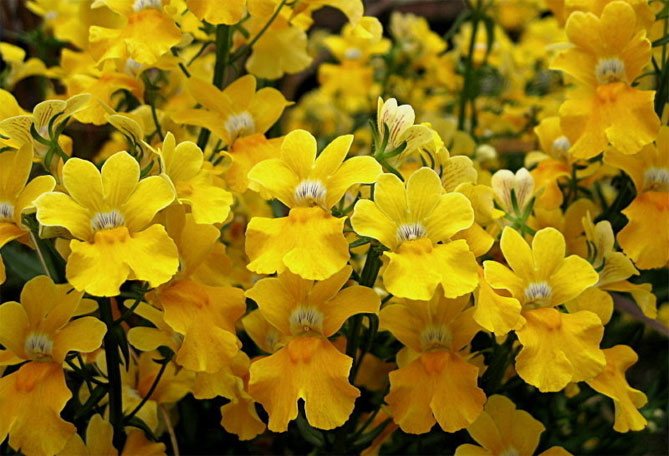

- Sunsatia Cranberry - red flowers.
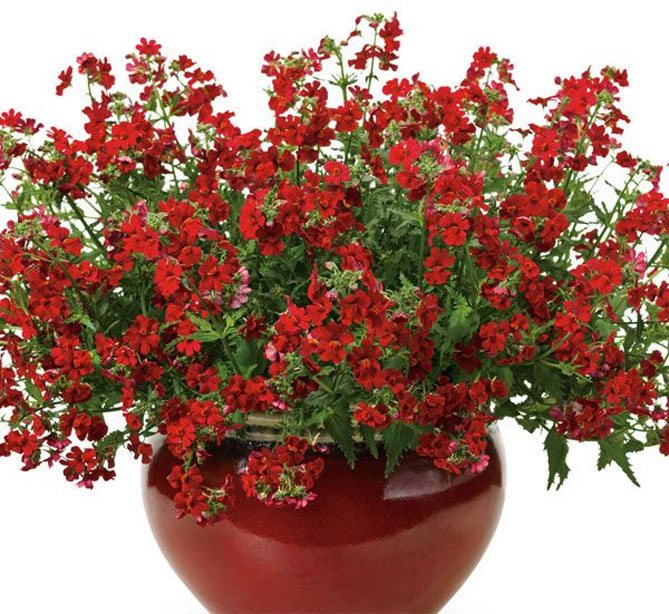

- Sunsatia Peach - flowers of different shades with a peach dominance.
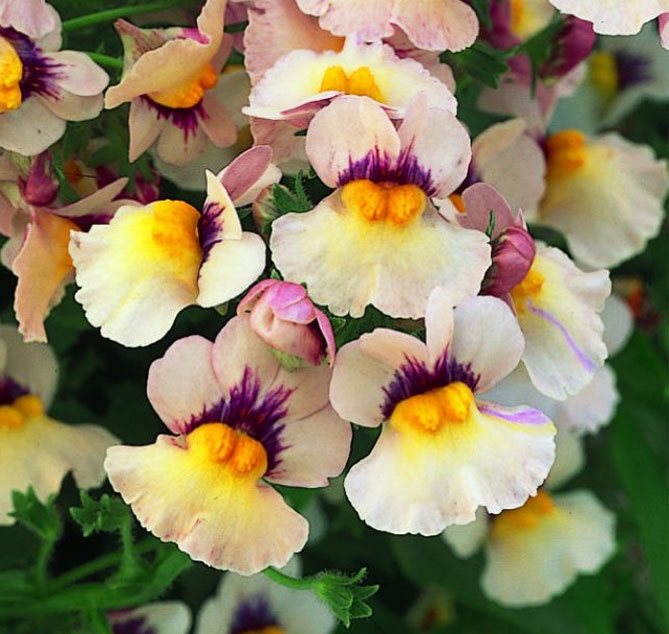

- Sunsatia Cassis - pink flowers.
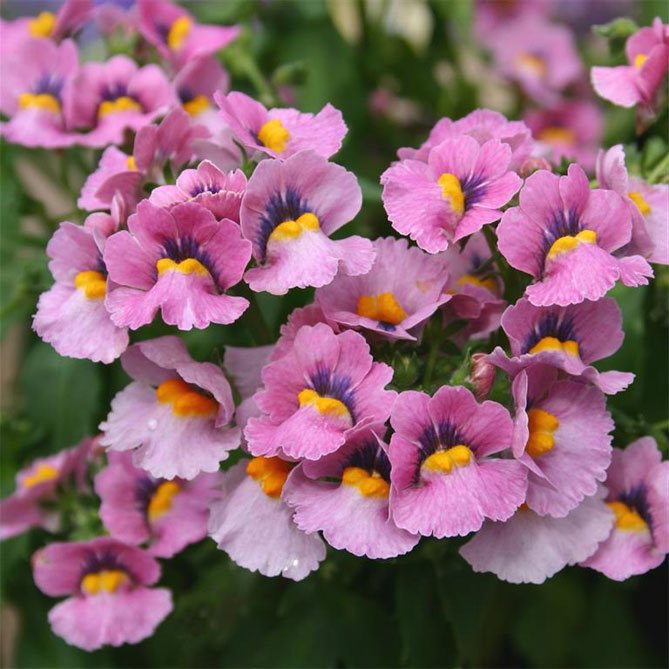

- Sunsatia Kumqwat is a very interesting cultivar with glowing flowers.
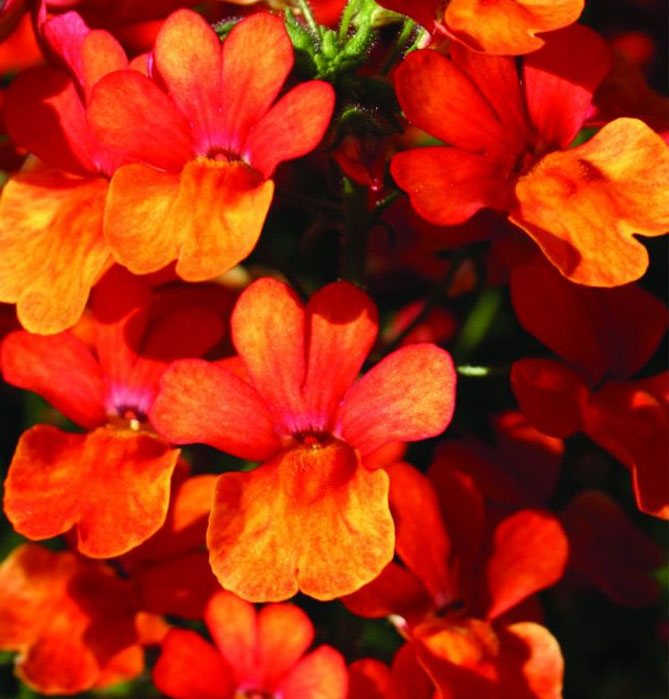

- Sunsatia Cherry on Ice - the variety surprises with its two-tone white and cherry blossoms.
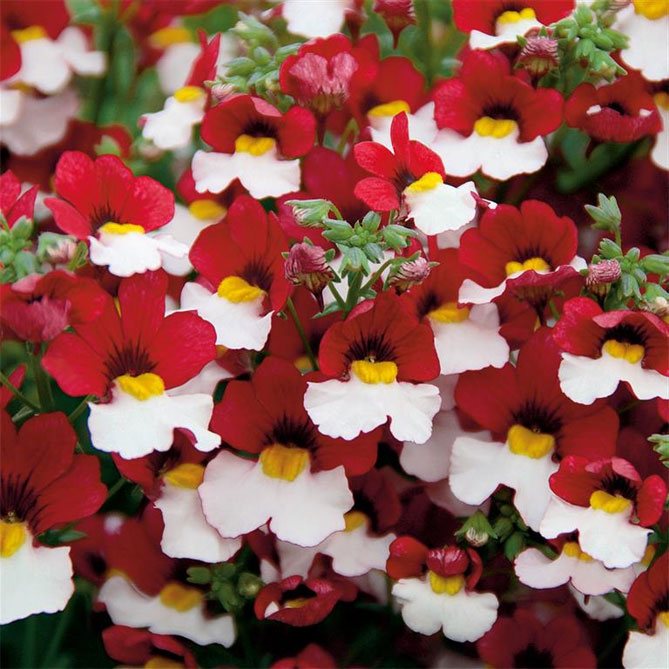

- Sunsatia Pomelo - yellow flowers.
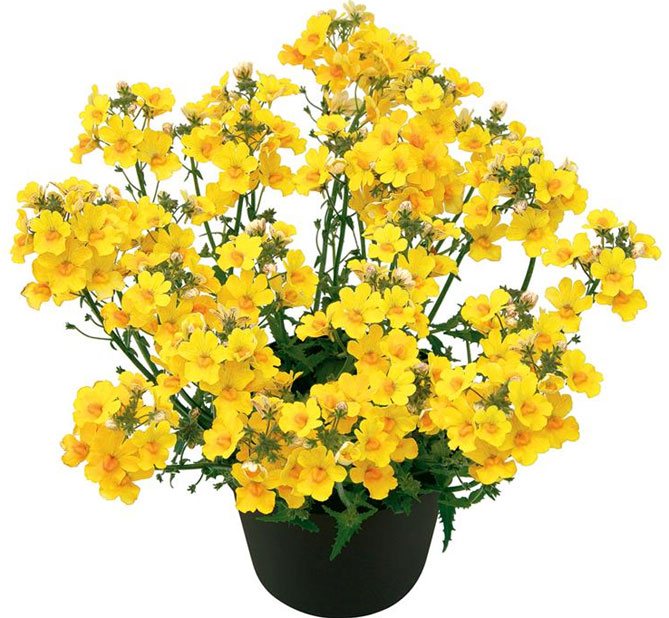

- Innocence Pink - a variety from the Innocence series, pink flowers.
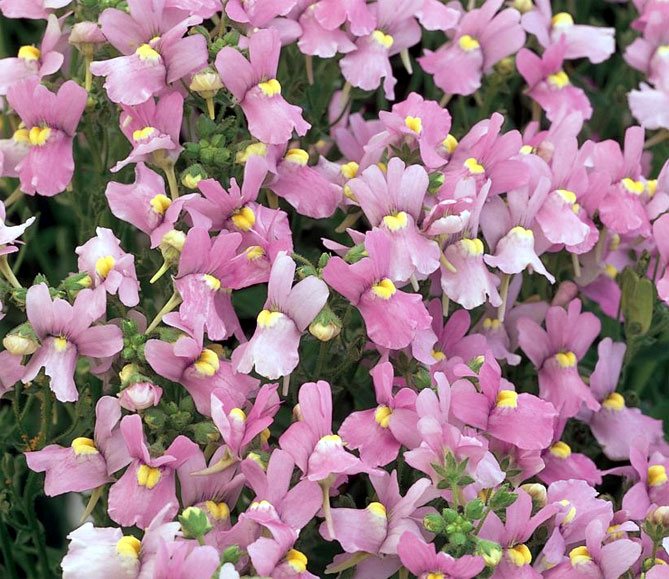

- Innocence White is a variety of the Innocence series, white flowers.
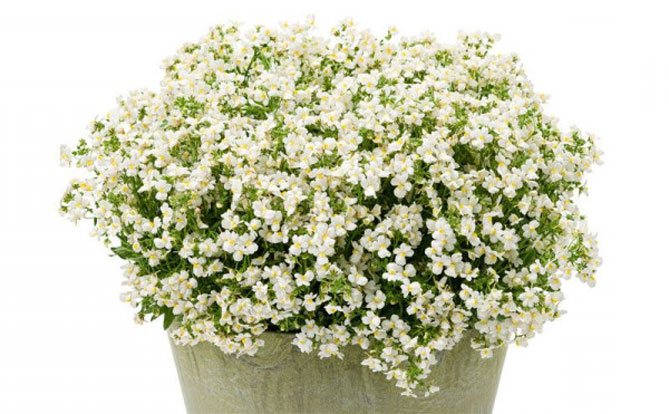

- Karoo Blue - a variant from the Karoo series, very compact, blue flowers.
- Karoo Soft Blue - charming flowers of delicate blue color.
- Sunsatia Raspberry is a variety from the very popular Sunsatia series with leafy shoots and crimson pink flowers.
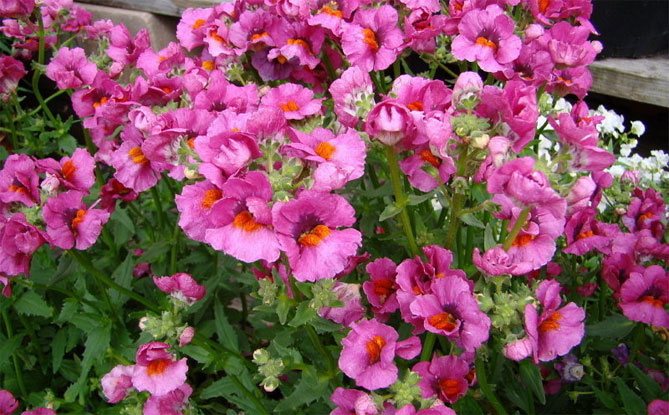

- Karoo White - white flowers.
- "Safari Pink" Safari Pink - Safari series, pink flowers.


- Karoo Violet Ice - purple-white flowers.
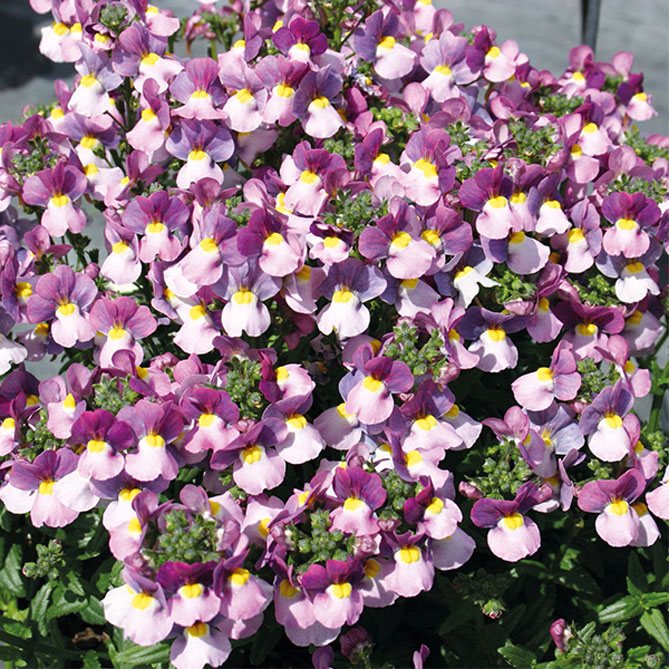

- "Blue Bird" Blue Bird - a variety of nemesia bushy species.
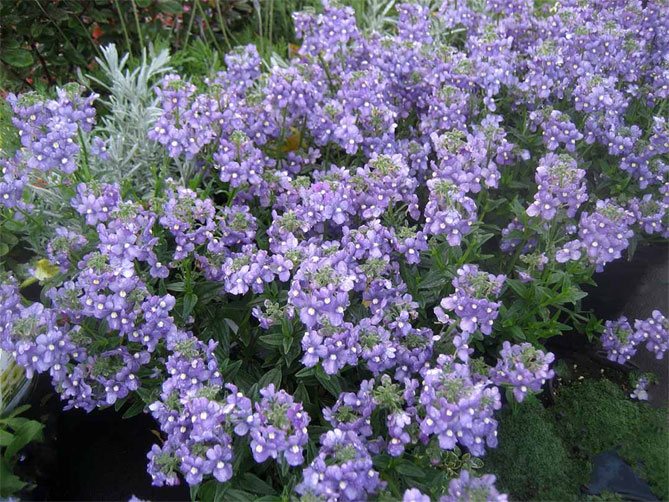

- Karoo Dark Blue - deep blue and purple flowers.
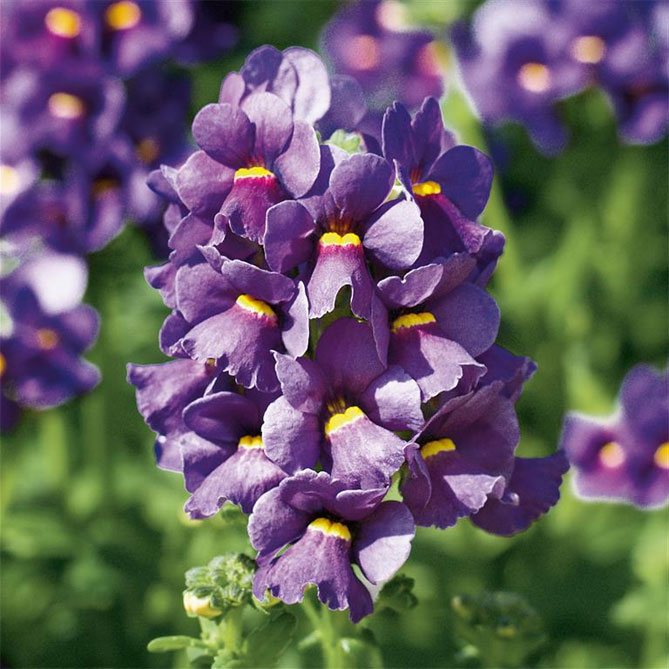

Views
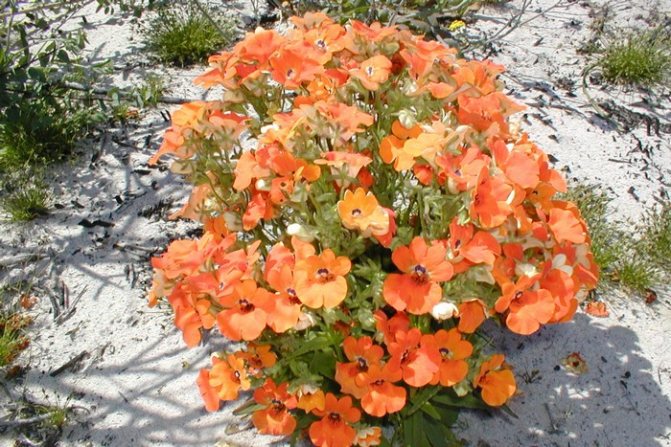

Lush nemesia (Nemesia floribunda), 20-30 cm high, white flowers, sometimes with dark purple stripes.
Goiter nemesia var. Suttonii (Nemesia strumosa var. Suttonii), has many varieties with relatively large colorful flowers.
Nemesia multicolored (Nemesia versicolor), the tallest cultivated species, approximately 35-50 cm tall, larger flowers and more abundant flowers.
Nemesia multicolored var. compacta (Nemesia versicolor var. Compacta), 20-25 cm high, forms dense bunches covered with flowers of various colors.
Sowing seeds
The commercially available nemesia refers to annual plants that can be grown from seedlings or sown directly into the ground.
Planting seedlings
Plants from seedlings will bloom faster. Seedlings are grown in early spring. Sowing seeds at home is carried out in April, in boxes. The seeds should germinate within 10 days. The optimum temperature for growing seedlings is 18 degrees Celsius.
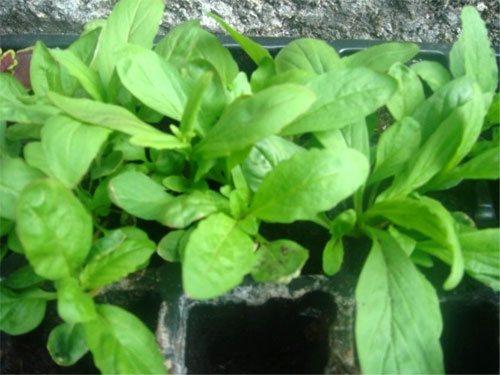

When the seedlings release 2 leaves, they carry out a dive and transplant them in bundles of several pieces in one place, with an interval of several centimeters. In the second half of May, seedlings are planted in flower beds or balcony boxes.
When to plant nemesia outdoors?
May is the month when seeds can be sown directly into open ground. They can be sown in different locations in the garden or in rows. After the emergence of seedlings, they should be thinned out, removing excess, weaker shoots, leaving individual plants approximately every 15-20 cm. It should be noted that in numerous groups, nemesia looks most impressive.
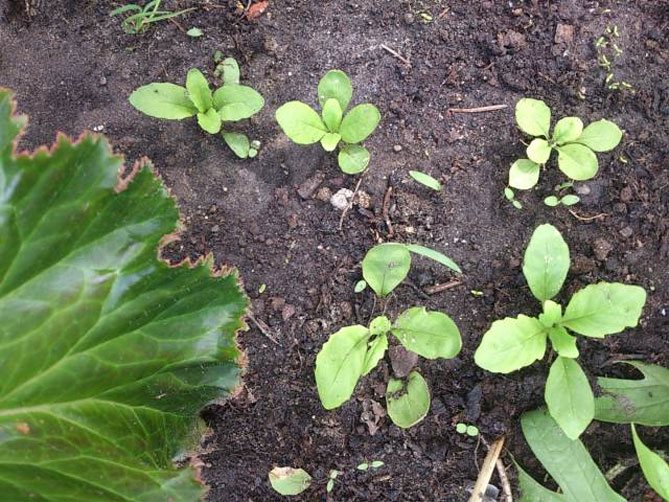

Diseases
Nemesia is susceptible to fungal diseases. To avoid damage to the flower, carry out the following care:
- monitor looseness soil, avoiding stagnation of water;
- watering the plant carry out only with warm water;
- as a preventive measure, water Nemesia potassium permanganate solution or phytosporin;
- watering flowers only at the root;
- when planting in the garden, observe the required distance between the bushes, not thickening the planting.
If rotted specimens are found, they are removed. The soil at the site of the flower's growth is watered with a hot raspberry solution of potassium permanganate.
Plant care
Nemesia is not demanding to care for, it grows on any soil, not very dry or poor. For long-term flowering, it needs watering, removing weeds, feeding, removing faded inflorescences. It is a plant that even a novice gardener can take care of as it does not require any special care procedures.
Watering
For nemesia to be beautiful and richly bloomed, in addition to the rays of the sun, it needs moist soil, but not wet. The plant can suffer from excess water, so the substrate on which it is planned to be sown must be enriched with gravel and a drainage layer. When growing in containers, be aware of permeable soil and drainage. Watering is carried out in accordance with the needs of the variety and the prevailing conditions. On hot and dry days, when growing in containers, it may be necessary to water the plants 2 times a day. Make sure the soil doesn't dry out too much between waterings.
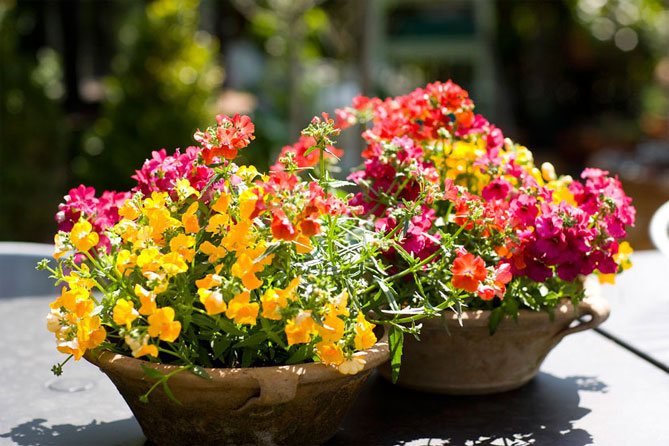

Top dressing
In order for nemesia to give many beautiful flowers, it is necessary to feed. In flower beds, it is advisable to plant plants in soil enriched with well-rotted compost. It is easier to use a complex fertilizer with a prolonged effect in containers.
In garden centers, you can buy special liquid multicomponent fertilizers for flowering plants, they are applied in accordance with the manufacturer's instructions.
Fertilizers are suitable for flowering plants with a high content of potassium and phosphorus, which allows you to get lush, wonderfully colored, impressive flowers.
Pruning
When the first 2-3 leaves appear, it is recommended to trim the tops of the plant so that it grows better. When the nemesia fades, the faded inflorescences need to be cut off so that the plant blooms again.
Wintering
Pot-grown nemesias should be transferred to a cold place during the winter, with temperatures below 20 degrees Celsius. They do not tolerate frost, but too high temperatures in heated rooms are also harmful to plants.
Diseases
The main problem in growing nemesia is fungal diseases. To prevent them, you must follow the rules of cultivation. To overcome the diseases that have already arisen, one should resort to specialized fungicidal preparations.
Diseases, pests and control of them
Nemesia suffers from root rot, other fungal diseases, since fungi reproduce well in moist soils. These diseases are difficult to treat. If the lesions are single, diseased plants are removed, and the soil and bushes are watered with water with fungicides.
For these flowers, a spider mite is dangerous - a red or greenish spider with a body size of 0.5 mm. The mite feeds on the juices of the leaves, which is why they wither, turn pale, and the flower dies.
To kill the tick, foliage, stems, branches and the ground near the flower are sprayed with acaricidal preparations Fitoverm, Talstar, Karate.
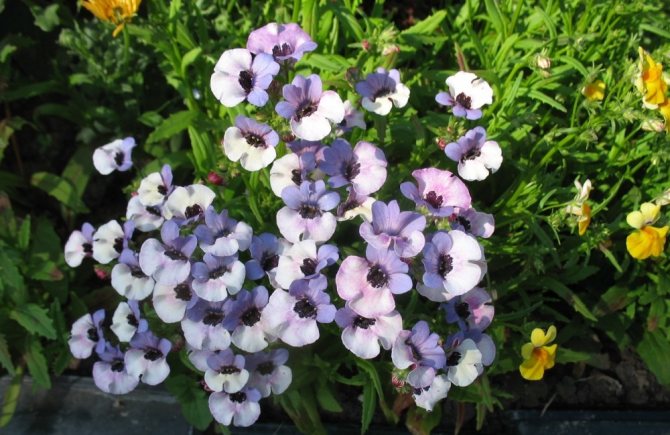

Nemesia can suffer from root rot, in which case the affected plants are harvested.
Application in garden design
Depending on the varieties and series of nemesia, the plants are suitable for growing in the garden, on the balcony, on the terrace. They are an excellent choice for planting in boxes, containers, hanging baskets.
In the garden, the plant can be used as a curb, fill the empty spaces on the rabat, for example, in a company with bulbous plants.
The nemesia flower is planted at a distance of 15-20 × 20 cm along the borders of flower beds, the edges of paths, in rock gardens. Also, the flower can be planted one at a time in the cracks, between the tiles.
Different varieties can create erect or hanging shoots. Nemesia ampelous looks beautiful in hanging pots on the balcony, terrace. New varieties, due to their strength and extraordinary beauty, can successfully compete with the popular balcony petunias and surfinias.
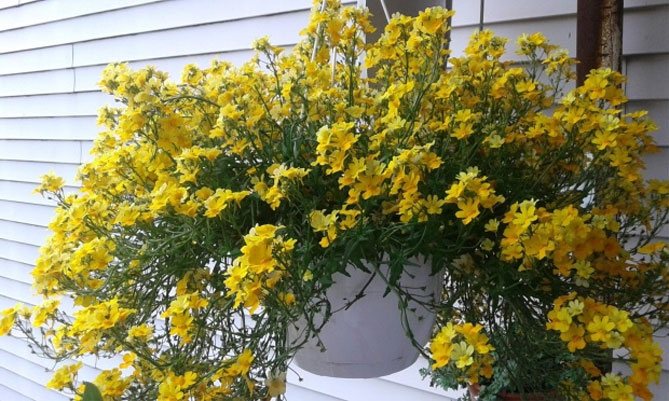

They can also decorate city beds and all other places that need to be quickly covered with a lush carpet of colorful flowers.
Nemesia on the windowsill - features of care and cultivation
To grow a flower in flower pots and flowerpots, Nemesia seedlings, planted as usual, are dived into flower containers. Considering that the root of the flower is pivotal, the depth of the pot for Nemesia should be at least 30 cm.
On a note. For home cultivation, they choose compact Nemesia varieties that look good indoors.
For the summer period, Nemesia can be displayed on a balcony or veranda. Carefully monitor the soil moisture in the pot, as it dries out faster in an enclosed space. Will help to solve the problem - automatic watering.
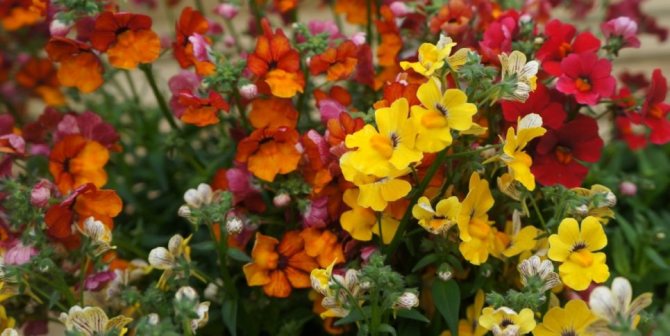

In winter, a flower will need to install additional lighting for full flowering, extending the day to 10 - 11 hours.
Testimonials
Sometimes nemesia sows itself and germinates the following spring, but the flowers are smaller and bloom less abundantly. I sow it every year from fresh seeds I buy from the store.
My favorite flower is nemesia.I sow it every year, it blooms beautifully all summer. Nemesia can be used to fill the “holes” after faded tulips and daffodils.
Nemesis does an excellent job of sowing directly into the ground and does not take up space on the windowsill. I sow on the balcony in pots in late March - early April, depending on the weather (I do not dive, sometimes I thin out the seedlings slightly). In August, I cut it off and continue to bloom. I prefer to sow multi-colored mixtures of varieties.
I am a flower "mother", but I care mainly about houseplants due to the absence of a private house and summer cottage. But to decorate the balcony, as a competition for my petunia, which has been blooming for a long time, I bought two bags of nemesia seeds ... What a delight!
The next year, I already thoroughly "surrounded" our store, collecting seeds for my mother (she lives in the village), and for my mother-in-law, and for friends. I also recommend you not to pass by these small, but such bright "violets"!
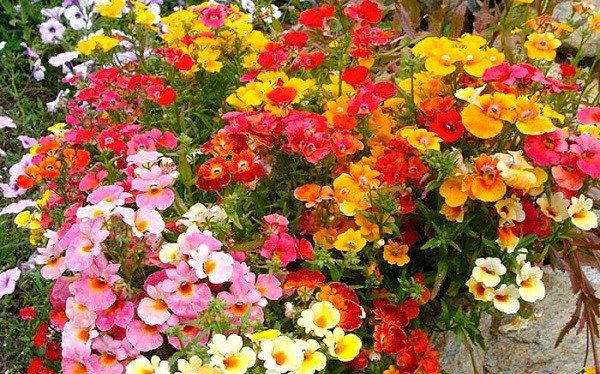

How to collect seeds
Several of the largest and brightest flowers are selected to collect seeds. When the capsules grow and become dry, they are cut off. The testes should be slightly immature. For ripening, they are placed on a saucer and placed in a dry place, where there is no direct sunlight.
Seeds are removed from the dried pods, dried and stored in a cool place with normal humidity. The seeds are packed in a regular paper envelope. The shelf life of seed is 2 years.
Reference. In hybrid varieties sown from harvested seeds, the color of the flowers of the mother plant is not preserved.
Nemesia, or in a simple way - multicolored "violets"
Few believe, but this miracle came to us from South Africa.
Biologists count about fifty types of nemesia (the flower is named after the goddess Nemesis, who is responsible ... no, not for nature or beauty, but for retribution).
Bushes can be annual and perennial. They are low - from 30 to 60 cm, with smooth or slightly pubescent leaves.
Flowers can have any color in general, there are even two-color species. Most of them resemble a violet, but there are also original forms (for example, the "Little Dragon" variety).
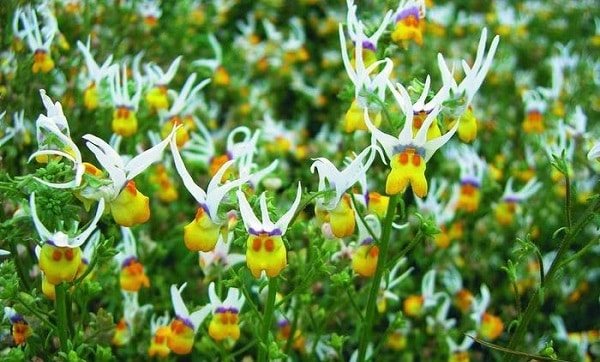

The closest relative of flowers is antirinum (snapdragon).
The fruits resemble a box filled with small seeds.
Variety selection
There are so many varieties that I will not even list them here. Most of them are garden ones, but there are also some ampelous ones (for pots and hanging baskets).
The most famous varieties for flower beds:
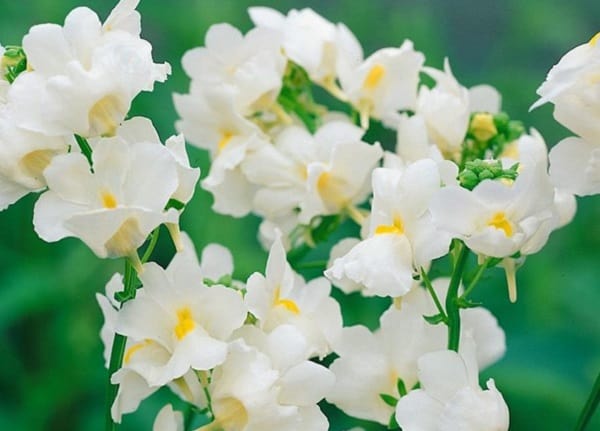

- Lush (lush) nemesia. Has white or pale blue flowers. Reminiscent of a wild look.
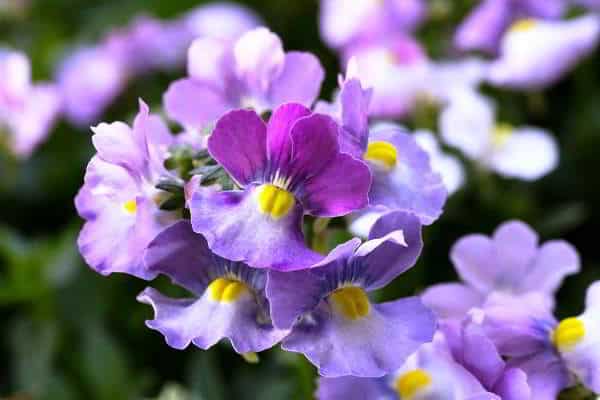

- Multi-colored. A favorite variety of botanists, it served as a "soil" for the creation of a dozen hybrids. Bright blue flowers are considered especially successful.
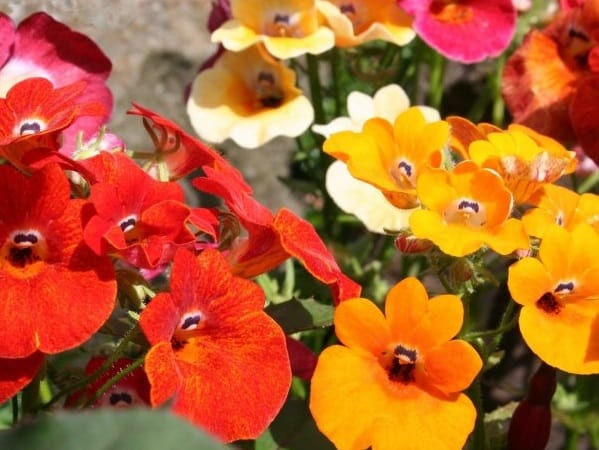

- Gobovic. It has sub-varieties with white, yellow, scarlet, white-red and tricolor petals.
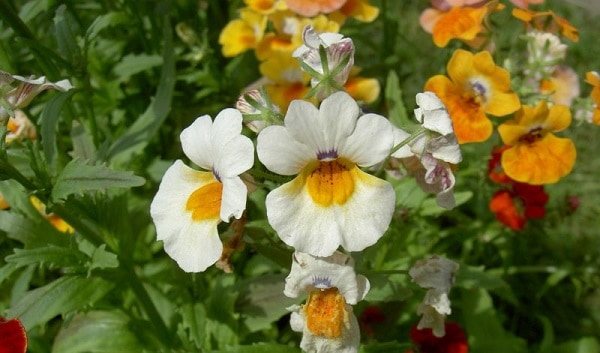

- Hybrid. The hybrid originated from the crossing of multicolored and goiter nemesia. It turned out a lot of bright sub-varieties of all shades (probably, only except for green, black and brown, and I doubt about the latter). Best: Carnival, Triumph, Tumbelina, Robe of the King, and Robe of the Cardinal.
And these flowers are bought for balconies:
Ampel nemesia is also known as sansatiya. It was taken out less than ten years ago. So far we have only 5 sub-varieties, the colors of which you can guess by the simple names: "Cranberry", "Pineapple", "Banana", "Coconut", "Lemon".
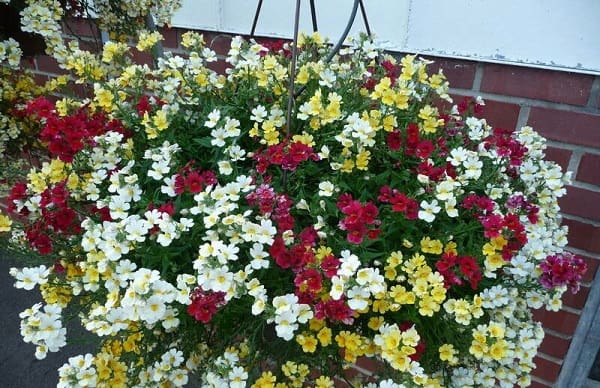

How to combine nemesia with other plants in landscaping
Nemesia, it seems, was simply created for decorating flower beds and flower beds; it is planted in rows along paths, in curbs. It looks very organic when decorating alpine slides, as well as rockeries, with decorative spots on lawns. Suitable for cutting into bouquets.
The plant goes well with other crops such as:
- petunias;
- marigold;
Nemesia bushes, thanks to their bushy shape, as if slightly falling apart by the stems, look great in flowerpots, boxes and hanging baskets, when landscaping balconies and open verandas.
Growing flowers from seeds
In fact, the plant reproduces in many ways - both by dividing the bush and by cuttings. But the first is bad because the roots of nemesia are injured during division, and they are very delicate. And the second one is simply inconvenient - the branches of the flower are too thin.
Therefore, seeds are the best way.
Sowing for seedlings
At the end of March (for flower beds) or in February (for terraces, loggias, verandas), the seeds are sown in a large "brotherly" pot.
The soil is chosen as usual floral. You can mix sand and peat if you like. The main requirement for the soil is that it must be moist and soft, loose.
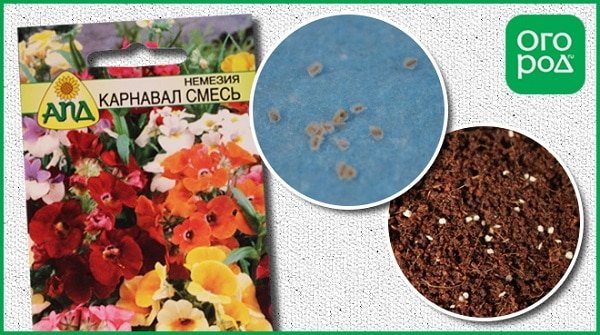

Many growers put some snow on top of the ground. This is done in order to clearly see how the seeds have laid down - their dark "little bodies" are perfectly visible in the snow and completely invisible on the ground. Although, of course, the photo above proves that nemesia seeds can be of a light shade.
The pot is placed in a bright, warm place. A greenhouse is formed on top (the top of the pot is tightened with a transparent film or covered with glass, but every day you need to raise it so that the soil breathes). The room temperature should be room temperature - about 20 degrees.
The sprouts will appear in 10 days.
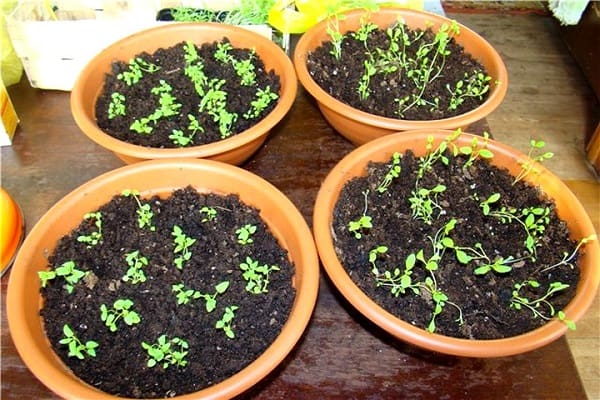

Seedling care
- The greenhouse is removed.
- The pot can be placed on a veranda or balcony, where the temperature is kept at about 10 degrees.
- The light should be bright (otherwise the sprouts will stretch out), but diffused so that it does not hurt the delicate leaves.
- A week later, dilute the compound fertilizer (but add more water than indicated on the bag) and spill the soil.
- From time to time water the seedlings with plain water, gently fluff the soil.
- A month later, when the kids grow a couple of real leaves, they can be dived, that is, they can be dug up and transferred to separate pots, although even disposable plastic cups will do. They need to be grown at 13 degrees, often watered.
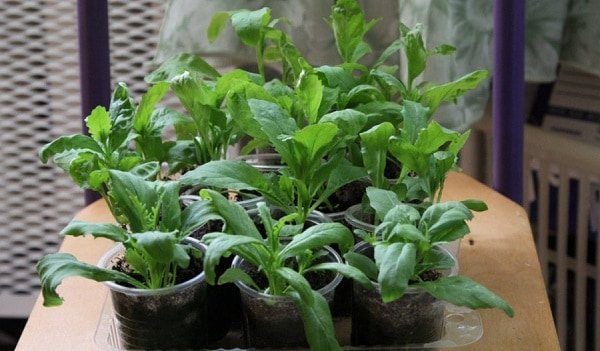

- If you grow flowers for the balcony, you can dive them directly into pots or hanging boxes.
- Shortly before planting on a flower bed, take the sprouts outside for 15 minutes every day (the so-called hardening of seedlings). For convenience, cups can be placed in a large tray.
Transplanting into open ground
This is done in late May - early June. The main condition is the absence of frost.
What conditions need to be created? Nemesia likes:
- partial shade or sun beds,
- ventilated areas,
- slightly acidic or neutral, drained soil.
When transplanting, the sprouts are transferred. The holes are dug strictly to the size of the roots with adhering soil (do not shake it off). The bushes will stretch to the sides, so leave 30 cm between them.
After planting, water the flowerbed and then mulch - this will protect the low "violets" from weeds and prevent moisture from evaporating too quickly.
Expect to bloom in the last weeks of June or the first days of July.
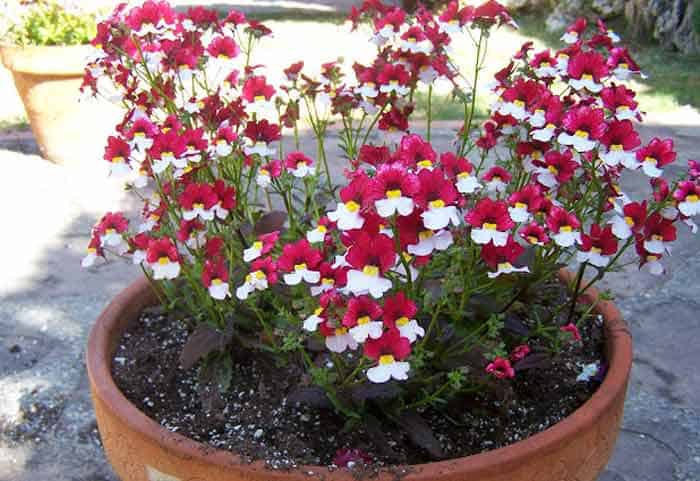

Is it possible to sow nemesia directly into a flower bed
Yes, but only if you live in a warm climate.
This is done like this:
- Choose a drained area, fertilize it with peat.
- At the end of April, or even better in May, sow the seeds. Water the flowerbed by spraying (this is the only way - if you take a watering can, it will wash off some of the seeds, and they will sprout up in "heaps").
- Cover the flower bed with plastic wrap that needs to be lifted frequently to help the sprouts breathe.
- Apply a complex mineral fertilizer by irrigation twice a month.
- When the sprouts turn green, the film can be removed. The "guys" need to be thinned out, leaving only the biggest ones. Leave 20 cm between the sprouts.
- Water the flower bed often. When the little nemesia grow up, grind the ground between them.
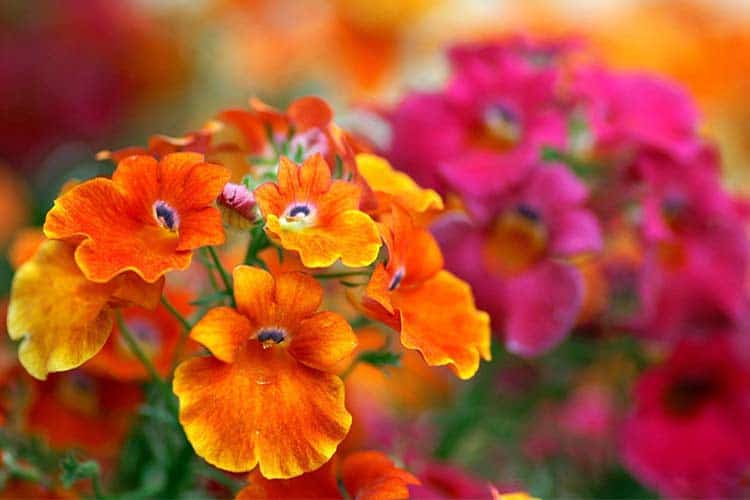

Planting nemesia in open ground
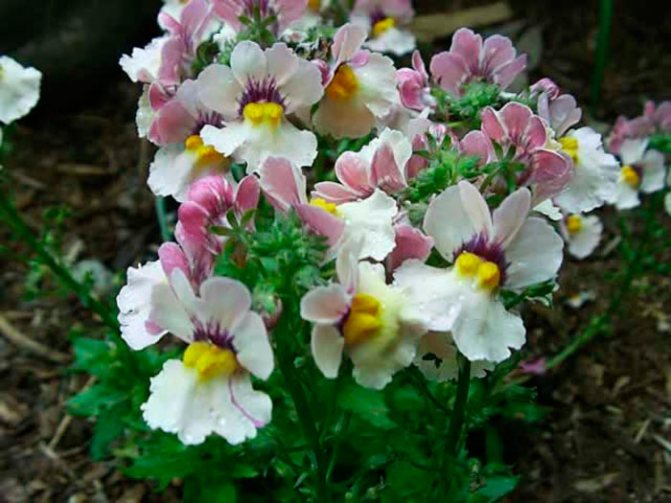

What time to plant
Transplanting seedlings into open soil is carried out only after there is no threat of night frosts, and the soil warms up well. As a rule, this time falls on the last days of May or the first days of June. For planting, you should choose a ventilated, well-lit, open area. The soil should be moist, well-drained, slightly acidic or neutral. As for the fertility of the soil, it should be medium. This plant can be grown in a small lace penumbra.
Landing features
Before you start planting seedlings in open soil, you should prepare the holes. Their size should be such that they can easily accommodate the entire contents of the pot (both the earthen ball and the root system). A distance of 0.2–0.3 m should be kept between the bushes, as they may fall apart a little. When the plants are planted and the holes are sealed, the area needs to be well watered. After the liquid is completely absorbed into the soil, its surface will need to be covered with a layer of mulch, this can prevent the soil from drying out too quickly. The flowering of such a plant can be seen in the last days of June, or the first in July.
How to care for a young and flowering plant
- Pinch the tops. Let the nemesia grow not upwards, but to the sides.
- Water the flowers often.
- From time to time, loosen the soil in the flower bed, remove weeds.
- You can feed the flowers 2 or 3 times a season. They like organics. From purchased funds, complex mineral mixtures are suitable.
Diseases and pests
Moisture-loving "violets" can attack the fungus. Therefore, do not fill the flowers, and take out the watering can only if you see that the ground in the flowerbed is completely dry.
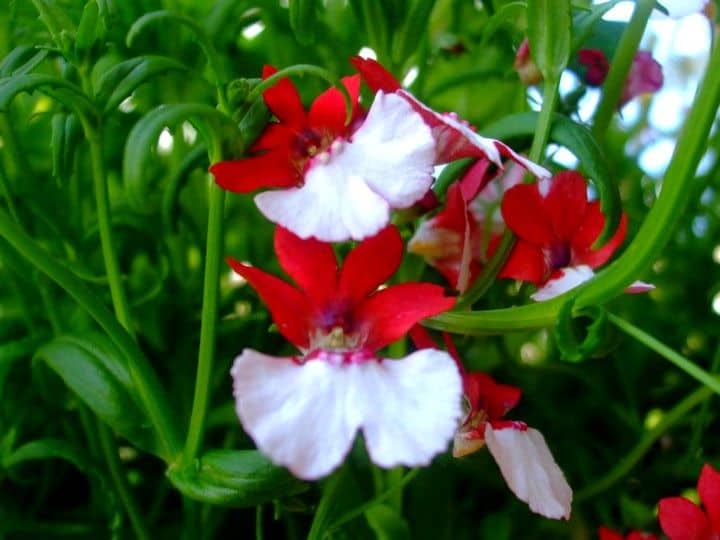

If the disease has already attacked, buy a fungicide.
As for insects, nemesia is afraid of spider mites. His presence will be betrayed by yellow / dry falling leaves, as well as a thin cobweb enveloping the bushes.
Give the enemy no mercy, buy an acaricide (poison from ticks, for example "Karate" or "Actellic" - the latter is good for indoor floriculture, so it can be useful to you later on caring for other flowers). Treat not only the plants, but also the soil in which they grow.
Description
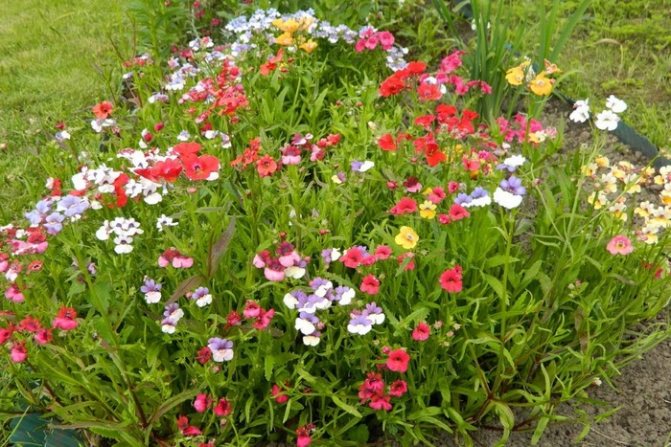

Nemesias grow in South America and Africa. Height, 20-50 cm. Flowering period, from June to September. Flower color, white to golden yellow, pink, cherry, purple to blue, with bicolor flowers. A place, require a sunny location, the east side is also suitable.
Where to get planting material
If you want to have this beautiful flower in your dacha or apartment, you need to decide how to get planting material.
Keep in mind that growing rooted scions has its drawbacks. Nemesia has a long root that is easily damaged when transplanting, this trouble can be avoided by growing it from seeds.
It is not difficult to obtain planting material. You can pick seeds from dead plants yourself or purchase them at the store. Look carefully at the dates: good germination lasts for two years, then it may turn out that not a single grain has sprout
.
The types of nemesia are so diverse that each person will definitely find a variety that suits his taste:
- the king's mantle strikes the eye with a noble combination of heavenly and white shades;
- the cardinal's robe resembles the blood-red robe of a clergyman;
- the carnival lives up to its name: bright juicy various colors create an atmosphere of celebration and fun;
- goiter nemesia is distinguished by large, as if inflated, inflorescences of the original form.
Look at photos and videos of different varieties, and you will see that you can pick up plants for the design of any site or room.
Seed planting: why you should use this method
Experienced gardeners prefer to plant nemesia with seeds, as this method gives the best result.Subject to all the rules for planting and caring for seedlings, you can get beautiful flower beds with different varieties of flowers every year.
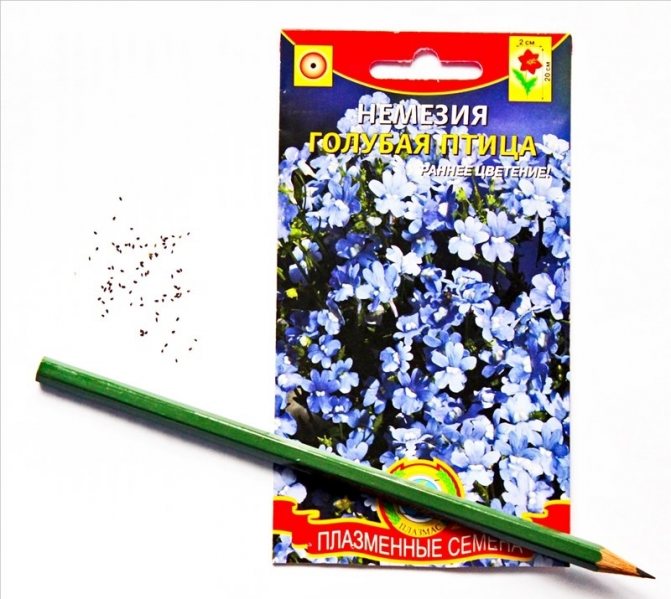

The problem with planting seeds is that they are very small, which can lead to planting several seeds in one place. This phenomenon is undesirable for young shoots, as they can crush each other.
1. Seven Secrets of Success:
| 1. Growing temperature: during the growing season, it is advisable to keep in a moderately warm atmosphere - at a temperature of about 18 ° C. The dormant period in nemesia begins in winter and should take place at a temperature of about 12 ° C. |
| 2. Lighting: Well-lit location with access to direct sunlight in the morning and evening. |
| 3. Watering and humidity: Water the nemesia regularly with softened water, but allow the topsoil 1 to 2 cm thick to dry out between waterings, the air humidity is high enough. |
| 4. Pruning: mostly sanitary, regular pinching of young shoots to form lateral branches, cardinal pruning after flowering. |
| 5. Priming: slightly acidic or neutral substrate with a loose texture and excellent drainage. |
| 6. Top dressing: 1 - 2 times a month, in spring and summer. In the middle of autumn, the frequency of dressings is reduced to naught and they are resumed only in the spring, with the first signs of new growth. |
| 7. Reproduction: spring sowing of seeds, stem cuttings in spring, division during spring transplantation. |
Botanical name: Nemesia.
Nemesia plant - family... Norichnikovye.
Origin... Subtropics of South Africa.
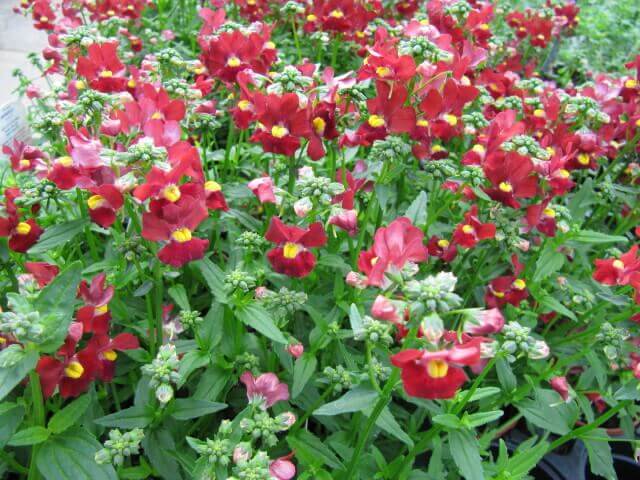

Description... The genus Nemesia consists of about 40 charming flowering, branched annuals and perennial herbaceous plants and shrubs.
Escapes strong, erect, with pubescent tops.
Leaves lanceolate, green, up to 10 cm long, simple, opposite.
Flowers often fragrant, up to 3 cm in diameter, in a wide range of colors - white, orange, yellow, pink, scarlet, crimson, lilac, collected in inflorescences - panicles or single. Nemesias are often found in flowers of 2 shades. With proper care, the plant blooms so profusely that the flowers almost completely hide the foliage.
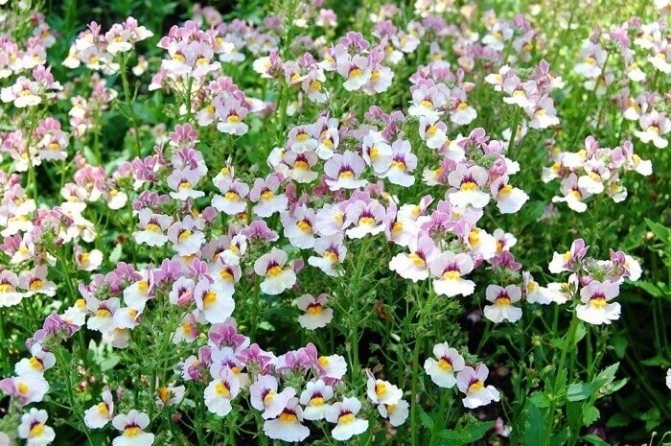

Height... 15 - 60 cm.
Reproduction
To get a new plant, you should use the seed or vegetative method.
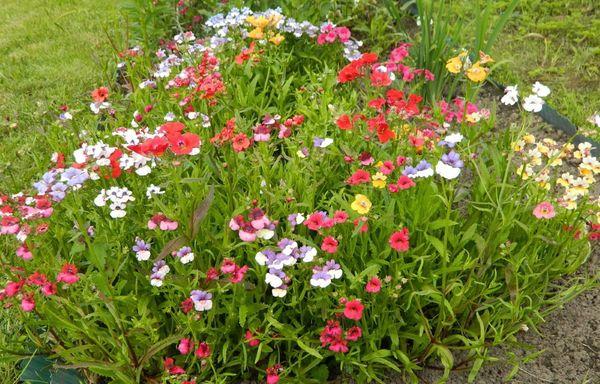

Vegetatively
Shoots are obtained from the top of the shoot. Each cutting should have 2-3 leaves. The soil mixture should be for succulents. The stalk is placed in a pot with a substrate, watered and covered with polyethylene. For better rooting, the room temperature should be 12-20 degrees.
Irrigation is carried out from a spray bottle. After 2-3 weeks, the greenhouse is removed.
A transplant to a permanent place is performed when the roots braid the entire earthen lump.
Care after landing
The first shoots will appear 15 days after planting. At this time, you need to remove the film and put the seedlings in a cool place with an air temperature of + 10 ... 15 ° C. After 7 days, you need to water the seedlings with water with the addition of potassium-phosphorus fertilizer.
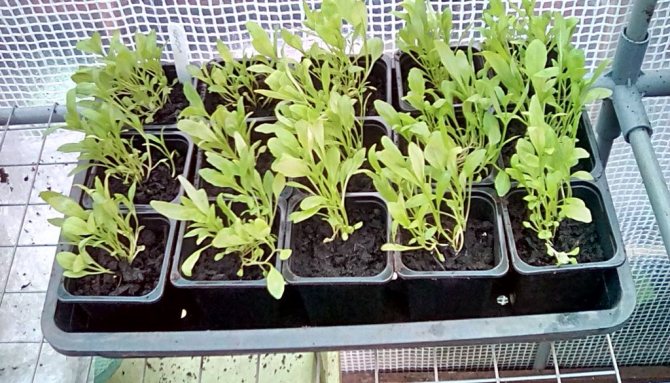

If the planting was carried out in a common pot, then after the appearance of the first leaves, a dive procedure must be carried out.
For this you need:
- Prepare individual pots.
- Remove the plants from the soil one by one and plant them in the chosen containers.
- Sprinkle with earth from a common pot.
If you do not make a pick in a timely manner, then the sprouts can get sick with a fungus.
When to plant seeds
The flower should be planted in early March so that it blooms in early summer. When planting nemesia in a cold region, the dates can be shifted by a month, that is, plant seedlings in April. In the southern regions, the planting can be shifted to February.
If the situation is favorable, the seeds will sprout 10 days after planting.. After 20 days, full sprouts can be obtained. This data can be used to determine when to plant seeds.
Moon calendar
The moon affects plants and can affect the quality of the crop.If you plant seeds on favorable days according to the lunar calendar, then nemesia will be lush, healthy and will become a real decoration of the flower bed.
- March - 8-14, 17, 23-25;
- April - 7-13, 16, 22-24;
- May - 7-13, 16, 22-24.
A favorable planting day cannot guarantee a good result if the rules for caring for the plant are not followed.
Landing rules: step by step instructions
Before planting seeds, you need to carry out preparatory work.
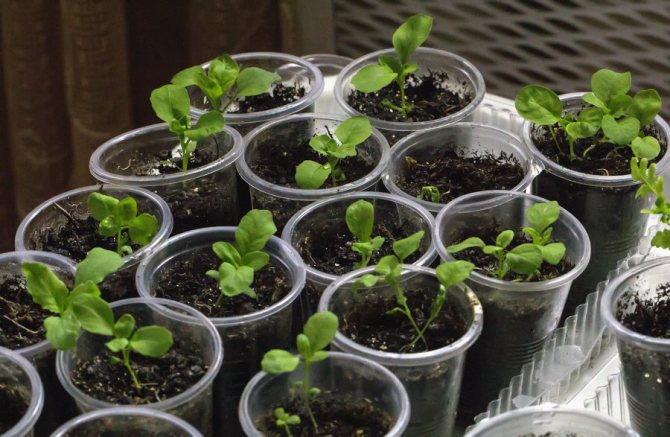

The first step is to prepare the ground. You can buy it at a specialty store or make your own. For this, soil, sand, compost and rotted humus are mixed in equal parts. All these components make the soil loose and nutritious.
Before sowing, the seeds do not need additional processing. They are mixed with sand (since they are very fine) to distribute them evenly when sowing.
Suitable containers:
- peat pots;
- plastic pots;
- cups.
The container must have holes in the bottom so that the roots can receive a sufficient amount of air.
Step-by-step instructions for planting seeds:
- Pour expanded clay on the bottom of the pot.
- Fill the container 2/3 with earth.
- Use a damp pencil or stick to plant the seeds, deepening them into the soil.
- Sprinkle with a thin layer of earth.
- Water the seedlings.
- Close the pots with foil.
The optimum temperature for keeping seedlings is + 20 ° C.
The amazing origin of the name
The plant, which is cute in appearance, is named after the formidable Nemesis, the ancient Greek goddess of retribution.
The height of herbaceous annuals varies between 30-60 cm. The stem is tetrahedral, covered with a short pile along its entire length, it branches well, the shoots are flexible, creeping. Ovate or oval leaves have serrated edges. Leaf plates, attached to short stalks, densely cover the stems and shoots.
Inflorescences appear in the leaf axils. The corolla has an interesting shape: it is tubular in shape, consists of an upper and lower tier, the upper part is four-lobed, the lower lip is larger, dicotyledonous. Colors in snow-white, blue, yellow, coral, purple tones, there are monochromatic and two-tricolor. The diameter of the flower is 1.5-2 cm.
After pollination, a capsule fruit is formed and ripens, filled with many small seeds. The seeds germinate for two years.

